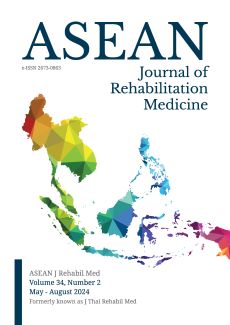Cross-Cultural Adaptation of the Fall Risk for Older People – A Community Setting (FROP-Com) Assessment Tool - Thai Version
Keywords:
Thai version, FROP-Com assessment tool, fall risk factors, Thai older people, cross-cultural adaptationAbstract
Objectives: The primary aim of this study was to translate and culturally adapt the Fall Risk for Older People – Community Setting (FROP-Com) assessment tool for older Thai people and to evaluate the instrument’s internal consistency and reliability. The secondary goal was to identify contributing risk factors for falls in individuals assessed with the Thai-version FROP-Com tool.
Study design: Cross-sectional descriptive study
Setting: Faculty of Medicine, Vajira Hospital, Bangkok, Thailand
Subjects: Thai community-dwelling elders aged 60 years and over
Methods: This study utilized standard guidelines for the cross-cultural adaptation process, which consisted of (a) forward translation, (b) synthesis translation, (c) backward translation, (d) expert committee review, and (e) test of the pre-final version. Internal consistency was assessed using Cronbach’s alpha coefficient. This study used intraclass correlation coefficients (ICC) with 95% confidence intervals to evaluate intra-rater and inter-rater reliability.
Results: The Thai FROP-Com assessment tool was successfully adapted for the Thai language. A total of 140 Thai community-dwelling participants aged 60 and older who met the inclusion criteria completed the study. Validation showed a good internal consistency of 0.96, while the intra-rater reliability was 0.92 and the Kappa coefficient was 0.89. The inter-rater reliability was 0.91 and the Kappa coefficient was 0.86.
Conclusions: The FROP-Com assessment tool displayed positive reliability and internal consistency for assessing risk factors among Thai older people. The tool was demonstrated to be valid and is now available for use with older members of the Thai population.
References
World Health Organization. WHO global report on falls prevention in older age. Geneva; 2007. [Cited 2023 Nov 11] Available from: https://www.who.int/ageing/publications/Falls_ prevention 7 March.pdf
Romli MH, Tan MP, Mackenzie L, Lovarini M, Suttanon P, Clemson L. Falls amongst older people in Southeast Asia: A scoping review. Public Health [Internet]. 2017 Apr [cited 2023 Oct 5];145:96-112. Available from: https://pubmed.ncbi.nlm.nih.gov/28359399/ doi: 10.1016/j.puhe.2016.12.035.
Jitapunkul S, Songkhla MN, Chayovan N, Chirawatkul A, Choprapawon C, Kachondham Y, Buasai S. Falls and their associated factors: a national survey of the Thai elderly. J Med Assoc Thai. 1998;81:233-42.
Assantachai P, Praditsuwan R, Chatthanawaree W, Pisalsarakij D, Thamlikitkul V. Risk factors for falls in the Thai elderly in an urban community. J Med Assoc Thai. 2003;86:124-30.
Situation of the Thai older persons 2021: Foundation of Thai Gerontology Research and Development Institute (TGRI), Institute for Population and Social Research Mahidol University; 2021. p. 124.
Thiamwong L, Thamarpirat J, Maneesriwongul W, Jitapunkul S. Thai falls risk assessment test (Thai-FRAT) developed for community-dwelling Thai elderly. J Med Assoc Thai. 2008;91(12):1823-32.
Close JCT and Lord SR. Fall assessment in older people. BMJ [Internet]. 2011 Sep [cited 2023 Oct 5];343:d5153. Available from: https://pubmed.ncbi.nlm.nih.gov/21917828/ doi: 10.1136/bmj.d5153
Russell MA, Hill KD, Day LM, Blackberry I, Dharmage SC. The reliability and predictive accuracy of the falls risk for older people in the community assessment (FROP-Com) tool. Age Ageing [Internet]. 2008 Nov [cited 2023 Oct 5]; 37(6):634-9. Available from: https://pubmed.ncbi.nlm.nih.gov/18565980/ doi: 10.1093/ageing/afn129
Beaton DE, Bombardier C, Guillemin F, Ferraz MB. Guidelines for the process of cross-cultural adaptation of self-report measures. Spine (Phila Pa 1976) [Internet]. 2000 Dec [cited 2023 Oct 5]; 25(24):3186–91. Available from: https://pubmed.ncbi.nlm.nih.gov/11124735/ doi: 10.1097/00007632-200012150-00014
Browner WS, Newman TB, Hully SB. Estimating sample size and power: applications and examples. In: Hully SB, Cummins SR, Browner WS, Grady DG, Newman TB, editors. Designing clinical research: an epidemiologic approach. 4th ed. Philadelphia, PA: Lippincott Williams & Wilkins; 2013. p. 55-83.
Mayring P. Qualitative content analysis - theoretical foundation, basic procedures and software solution. [Internet] Gesis Leibniz Institute for the Social Sciences, Klagenfurt; 2014. [cited 2024 Feb 23] Available from: https://nbn-resolving.org/urn:nbn:de:0168-ssoar-395173
Fliess JH. Measuring nominal scale agreement among many raters. Psychol Bull [Internet]. 1971 [cited 2024 Feb 24];76:378-82. Available from: https://europepmc.org/article/CTX/c6682 doi: 10.1037/h0031619
Suttanon P, Hill K, Said C, Dodd K. A longitudinal study of change in falls risk and balance and mobility in healthy older people and people with Alzheimer disease. Am J Phys Med Rehabil [Internet]. 2013 Aug [cited 2024 Mar 20];92:676–85. Available from: https://doi.org/10.1097/phm.0b013e318278dcb3
Price R, Choy N. Investigating the relationship of the functional gait assessment to spatiotemporal parameters of gait and quality of life of individuals with stroke. J Geriatr Phys Ther [Internet]. 2019 Oct/Dec [cited 2024 Mar 20];42(4):256-64. Available from: https://doi.org/10.1519/jpt.0000000000000173
Mascarenhas M, KD, Barker A, and Burton E. Validity of the Falls Risk for Older People in the Community (FROP-Com) tool to predict falls and fall injuries for older people presenting to the emergency department after falling. Eur J Ageing [Internet]. 2019 Jan [cited 2024 Mar 20];16(3):377-86. Available from: https://doi.org/10.1007/s10433-018-0496-x
Downloads
Published
How to Cite
Issue
Section
License

This work is licensed under a Creative Commons Attribution-NonCommercial-NoDerivatives 4.0 International License.






